open hood Acura TL 2000 3.2 Owner's Manual
[x] Cancel search | Manufacturer: ACURA, Model Year: 2000, Model line: TL, Model: Acura TL 2000Pages: 311, PDF Size: 3.05 MB
Page 53 of 311
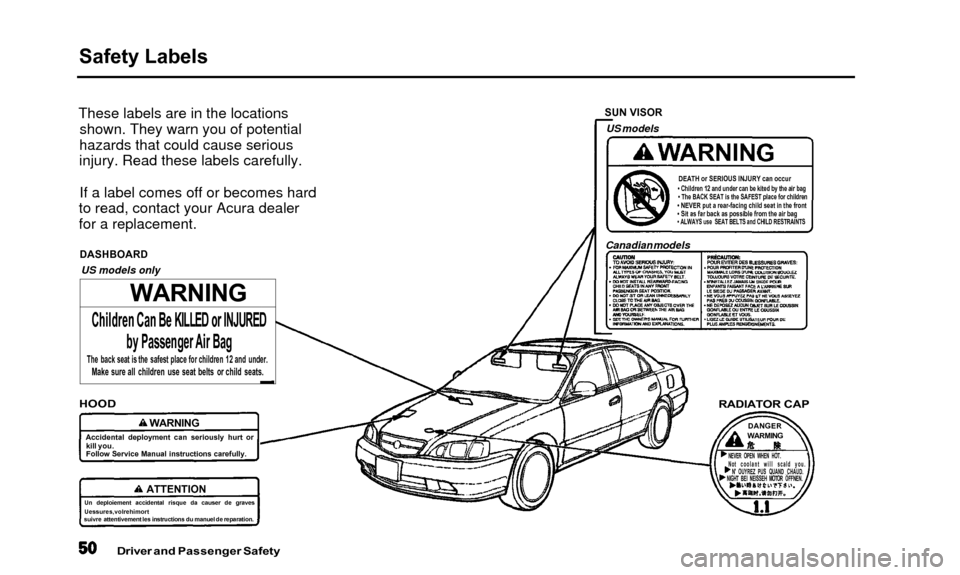
Safety Labels
These labels are in the locationsshown. They warn you of potential
hazards that could cause serious
injury. Read these labels carefully.
If a label comes off or becomes hard
to read, contact your Acura dealer
for a replacement.
DASHBOARD
US models only SUN VISOR
US models
DEATH or SERIOUS INJURY can occur• Children 12 and under can be kited by the air bag• The BACK SEAT is the SAFEST place for children
• NEVER put a rear-facing child seat in the front
• Sit as far back as possible from the air bag
• ALWAYS use SEAT BELTS and CHILD RESTRAINTS
Canadian models
HOOD
Accidental deployment can seriously hurt or
kill you.
Follow Service Manual instructions carefully.
Un deploiemen t accidental risque da causer de graves
Uessures,volrehimort
suivre attentivemen t les instructions du manuel de reparation.
Driver and Passenger Safety
RADIATOR CAP
DANGERWARMING
NEVER OPEN WHEN HOT. '
Not coolant will scald you. N' OUYREZ PUS QUAND CHAUD.
NIGHT BEI NEISSEH MOTOR OFFNEN.
WARNING
Children Can Be KILLED or INJURED
by Passenger Air Bag
The back seat is the safest place for children 12 and under.Make sure all children use seat belts or child seats.
WARNING
ATTENTION
Page 146 of 311

Security System
The security system helps to protectyour vehicle and valuables from theft.
The horn sounds and a combination of headlights, parking lights, side
marker lights and taillights flashes if someone attempts to break into your
vehicle or remove the radio. This alarm continues for two minutes,
then the system resets. To reset an alarming system before the two
minutes have elapsed, unlock either
front door with the key or the remote transmitter.
The security system sets auto- matically fifteen seconds after you
lock the doors, hood, and trunk. For
the system to activate, you must lock
the doors from the outside with the
key, lock tab, door lock switch, or
remote transmitter. The securitysystem light next to the driver's door
lock starts blinking immediately to show you the system is setting itself.SECURITY SYSTEM LIGHT
Once the security system is set,
opening any door (without using the
key or the remote transmitter), or the hood, will cause it to alarm. Italso alarms if the radio is removed
from the dashboard or the wiring is cut. With the system set, you can still
open the trunk with the remote
transmitter without triggering the alarm. The alarm will sound if the
trunk is opened with the trunk
release handle.
The security system will not set if the hood, trunk, or any door is not
fully closed. If the system will not set,check the Door Monitor on the
instrument panel (see page 56), to see if the doors and trunk are fully
closed. Since it is not part of the
monitor display, manually check the
hood.
Do not attempt to alter this system or add other devices to it.
Comfort and Convenience Features
Page 148 of 311
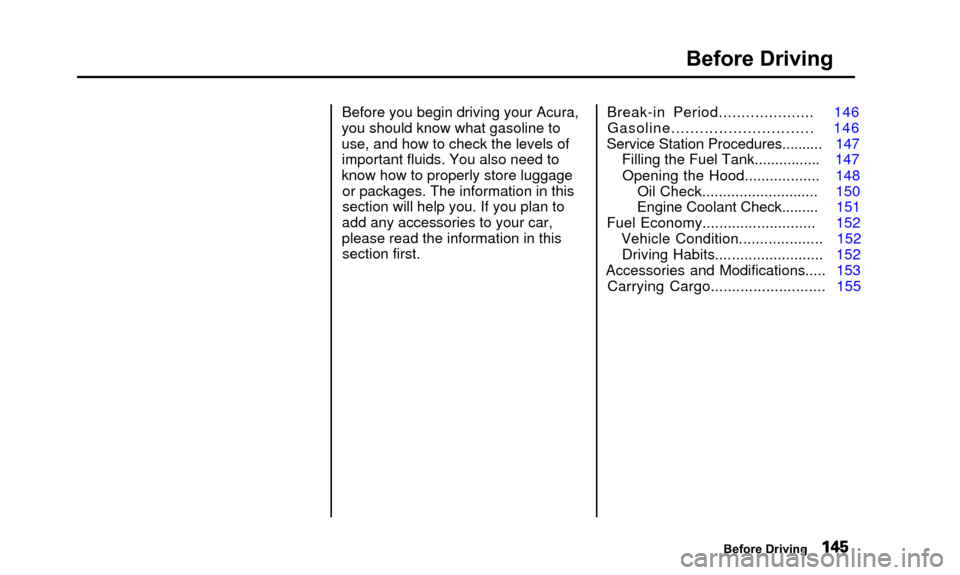
Before Driving
Before you begin driving your Acura,
you should know what gasoline to
use, and how to check the levels of important fluids. You also need to
know how to properly store luggage or packages. The information in this
section will help you. If you plan to
add any accessories to your car,
please read the information in this section first. Break-in Period
..................... 146
Gasoline.............................. 146
Service Station Procedures.......... 147
Filling the Fuel Tank ................ 147
Opening the Hood.................. 148
Oil Check............................
150
Engine Coolant Check ......... 151
Fuel Economy...........................
152
Vehicle Condition.................... 152
Driving Habits.......................... 152
Accessories and Modifications..... 153
Carrying Cargo........................... 155
Before Driving
Page 151 of 311
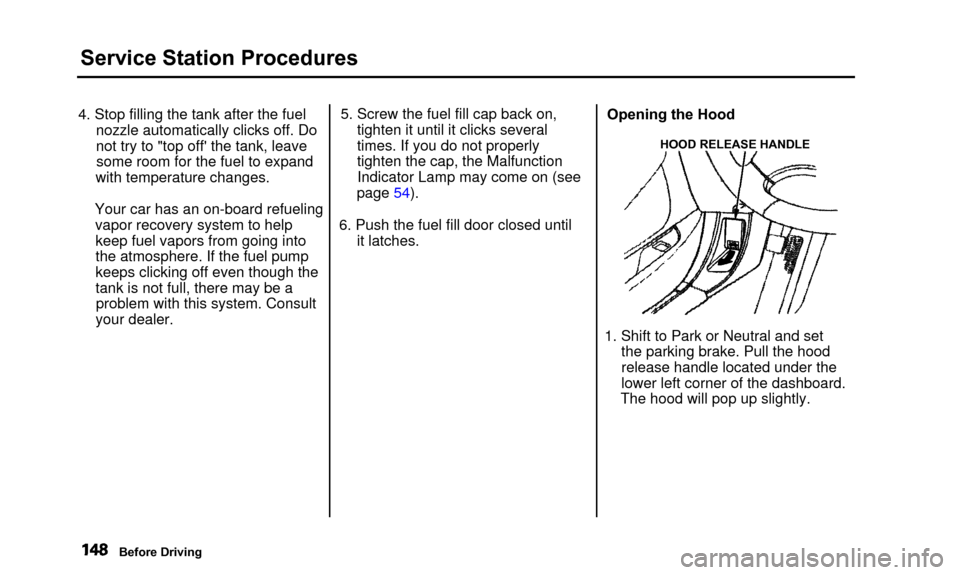
Service Station Procedures
4. Stop filling the tank after the fuelnozzle automatically clicks off. Do
not try to "top off' the tank, leavesome room for the fuel to expand
with temperature changes.
Your car has an on-board refueling vapor recovery system to helpkeep fuel vapors from going into
the atmosphere. If the fuel pump
keeps clicking off even though the
tank is not full, there may be aproblem with this system. Consult
your dealer. 5. Screw the fuel fill cap back on,
tighten it until it clicks several
times. If you do not properly
tighten the cap, the MalfunctionIndicator Lamp may come on (see
page 54).
6. Push the fuel fill door closed until it latches. Opening the Hood
HOOD RELEASE HANDLE
1. Shift to Park or Neutral and set
the parking brake. Pull the hood
release handle located under the
lower left corner of the dashboard.
The hood will pop up slightly.
Before Driving
Page 152 of 311

Service Station Procedures
LATCH
2. Standing in front of the car, putyour fingers under the front edgeof the hood to the right of center.Slide your hand to the Ieft until
you feel the hood latch handle. Push this handle up until it
releases the hood. Lift the hood. If you can open the hood without
lifting the hood latch handle, or
the hood latch handIe moves stiffly or does not spring back as
before, the mechanism should be
cleaned and lubricated (see page 215).
3. Lift the hood up most of the way.The hydraulic supports will lift itup the rest of the way and hold itup.
To close the hood, lower it to about a foot (30 cm) above the fender, then
press down firmly with your hands.
After closing the hood, make sure it is securely latched.
CONTINUED
Before Driving
Page 207 of 311

Engine Oil
WASHER DRAIN BOLT
2. Open the hood and remove theengine oil fill cap. Remove the oil
drain bolt and washer from the
bottom of the engine. Drain the oil
into an appropriate container.
OIL FILTER
3. Remove the oil filter and let the remaining oil drain. A special
wrench (available from your Acura dealer) is required to remove the
filter. 4. Install a new oil filter according to
instructions that come with it.
5. Put a new washer on the drain bolt, then reinstall the drain bolt.
Tighten it to: 29 lbf-ft (39N-m, 4.0 kgf-m)
Maintenance
Page 212 of 311

Cooling System
1. Turn the ignition ON (II). Turnthe heater temperature controldial to maximum heat (climate
control to 90°F/32°C). Turn off
the ignition. Open the hood. Make sure the engine and radiator are
cool to the touch.
2. Remove the radiator cap.
DRAIN PLUG
DRAIN BOLT
3. Loosen the drain plug on thebottom of the radiator. Thecoolant will drain through thesplash guard. Loosen the drain
bolt at the rear of the engine cylinder block.
RESERVE TANK CAP RESERVE TANK
HOLDER
4. Remove the reserve tank from itsholder by pulling it straight up.Drain the coolant, then put the
tank back in its holder.
5. When the coolant stops draining, tighten the drain plug at the
bottom of the radiator.
CONTINUED
Maintenance
Page 239 of 311
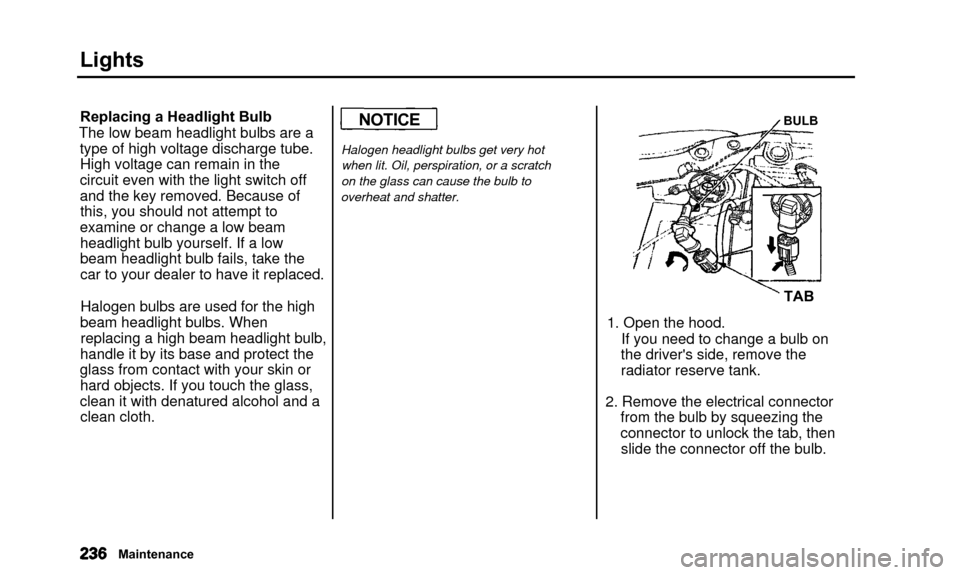
Lights
Replacing a Headlight Bulb
The low beam headlight bulbs are a type of high voltage discharge tube.High voltage can remain in the
circuit even with the light switch off
and the key removed. Because of this, you should not attempt to
examine or change a low beam headlight bulb yourself. If a low
beam headlight bulb fails, take the
car to your dealer to have it replaced.
Halogen bulbs are used for the high
beam headlight bulbs. When replacing a high beam headlight bulb,
handle it by its base and protect the
glass from contact with your skin or hard objects. If you touch the glass,
clean it with denatured alcohol and a clean cloth.
Halogen headlight bulbs get very hot
when lit. Oil, perspiration, or a scratch
on the glass can cause the bulb to
overheat and shatter. BULB
TAB
1. Open the hood. If you need to change a bulb on
the driver's side, remove the
radiator reserve tank.
2. Remove the electrical connector from the bulb by squeezing the
connector to unlock the tab, thenslide the connector off the bulb.
Maintenance
NOTICE
Page 266 of 311

Jump Starting
To jump start your car, follow thesedirections closely:
1. Open the hood and check the physical condition of the battery(see page 220). In very cold
weather, check the condition of
the electrolyte. If it seems slushy or like ice, do not try jump starting
until it thaws.
NOTICE
If a battery sits in extreme cold, the
electrolyte inside can freeze.
Attempting to jump start with a frozen battery can cause it to rupture.
2. Turn off all the electrical acces- sories: climate control, stereo
system, lights, etc.
Put the transmission in Neutral or
Park and set the parking brake. 3. Remove the battery cover.
4. Connect one jumper cable to the positive (+) terminal on the
booster battery. Connect the otherend to the positive (+) terminal
on your Acura's battery. 5. Connect the second jumper cable
to the negative (—) terminal on
the booster battery. Connect theother end to the grounding strap
as shown. Do not connect this
jumper cable to any other part of the engine.
CONTINUED
Taking Care of the Unexpected
Page 268 of 311
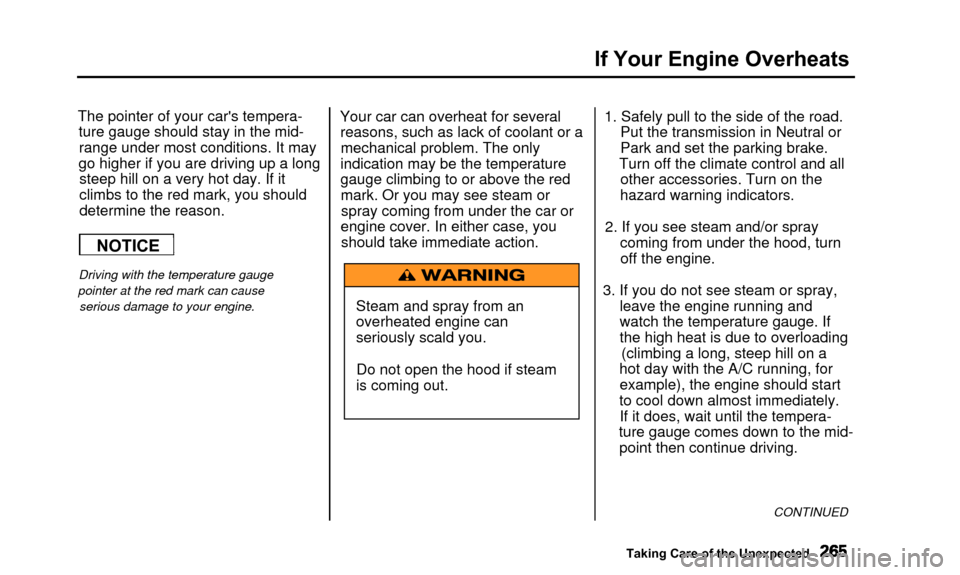
If Your Engine Overheats
The pointer of your car's tempera-ture gauge should stay in the mid-range under most conditions. It may
go higher if you are driving up a long steep hill on a very hot day. If it
climbs to the red mark, you should
determine the reason.
Driving with the temperature gauge
pointer at the red mark can cause serious damage to your engine.
Your car can overheat for severalreasons, such as lack of coolant or amechanical problem. The only
indication may be the temperature
gauge climbing to or above the red mark. Or you may see steam orspray coming from under the car or
engine cover. In either case, you should take immediate action.
Steam and spray from an
overheated engine can
seriously scald you.Do not open the hood if steam
is coming out. 1. Safely pull to the side of the road.
Put the transmission in Neutral or
Park and set the parking brake.
Turn off the climate control and all other accessories. Turn on the
hazard warning indicators.
2. If you see steam and/or spray coming from under the hood, turnoff the engine.
3. If you do not see steam or spray, leave the engine running and
watch the temperature gauge. If
the high heat is due to overloading(climbing a long, steep hill on a
hot day with the A/C running, for example), the engine should start
to cool down almost immediately. If it does, wait until the tempera-
ture gauge comes down to the mid- point then continue driving.
CONTINUED
Taking Care of the Unexpected
NOTICE